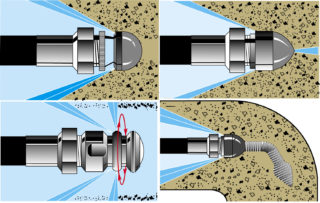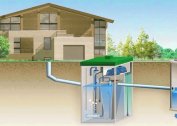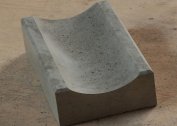With mechanical cleaning of the sewer, a blockage is punched in a certain area. But on the walls of the pipeline there is a constant settling of solid particles, the inner passage narrows, plugs appear much more often. The hydrodynamic method of cleaning highways solves this problem.
The work of hydrodynamic technology
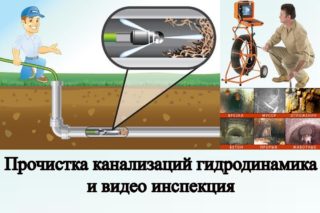 The technique is based on the active action of a high-pressure water stream from one and a half hundred to five hundred atmospheres. The technology is quite simple: a hose is introduced into the pipeline, water flows through its nozzles under pressure, eliminating clogging.
The technique is based on the active action of a high-pressure water stream from one and a half hundred to five hundred atmospheres. The technology is quite simple: a hose is introduced into the pipeline, water flows through its nozzles under pressure, eliminating clogging.
Inside the pipeline, such a "projectile" moves with the help of jet propulsion. Behind the nozzle there is a series of nozzles that are directed back to the advancement of the hose. When water is turned on, the nozzle begins to move like a rocket.
Moving along the pipe, the nozzle with nozzles knocks down all the growths. Nozzles vary in size and function. Their choice depends on the cross-section of the pipeline, the type of sewer communications and how clogged they are. For example, to eliminate traffic jams and congestion, a breakdown nozzle is installed, and a rotary one is used for preventive cleaning of storm sewers. The principle of operation is the same for any hydromechanical equipment, regardless of size and power indicators.
Hydrodynamic flushing is universal, it is used for both external and internal sewerage. It comprehensively affects the system from the inside, allows you to destroy and eliminate all blockages and mud growths, including plant roots, sometimes sprouting into sewer communications.
Hydro-flushing unit
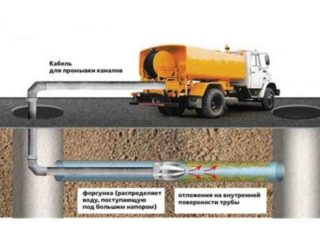 Hydrodynamic equipment for cleaning the sewage system consists of the following elements:
Hydrodynamic equipment for cleaning the sewage system consists of the following elements:
- powerful pumping equipment;
- drive - electric or gasoline;
- high pressure hose;
- tip on which the nozzle is installed (spray nozzle).
For a hydrodynamic device, a pump is needed that creates a lot of pressure (about 200 MPa). Previously, devices of similar power were bulky and weighed a lot. Today, the units are lifting and compact.
Each nozzle (spray nozzle) is selected for a specific purpose. Any nozzle element is designed so that during operation it moves forward due to the strong ejection of water jets in the opposite direction. This technical solution contributes to the self-movement of the hose through the pipe and cleaning.
The nozzle is connected to the pump using a flexible hose. This method of joining allows you to clean pipes of any design, even multilevel complexes.
Equipment options
The choice of installation is made depending on several key indicators:
- Section of the pipeline. For domestic sewage systems, equipment is usually used that allows you to clean pipes with a diameter of 50–250 mm. Such units are portable or have wheels.
- The length of the line between the two inspection wells. The shortest working hose is 15 m, but professional equipment often includes flexible elements 30 m long.
- The purpose of the unit is for personal use or industrial use.
By design, household and industrial appliances are similar. The first are characterized by small power indicators. They are intended for servicing pipelines with a cross section of 25–350 mm.They are used for sewers indoors.
Special machines - units with powerful pumps - are used to flush pipelines with a cross section of more than 350 mm. Recommended for external sewers and communication lines operating in difficult conditions.
Domestic installations and industrial devices are divided into two types depending on the power source. In independent devices with internal combustion engines, the pressure can reach 500 atmospheres, which allows for greater productivity of the equipment. It is possible to clean the pipeline of any section. Installations with three-phase motors operating on alternating current are used for flushing systems with a cross section of not more than 200 mm.
When buying a hydrodynamic device, you need to remember that hose extension is not recommended: when working under high pressure, it may break at the junction. It is better to immediately buy a flexible element of the required length.
For self-washing pipes, it is not necessary to buy a separate installation. The Karcher washing machine will do the job. But in the manual for the selected model, this function should be mentioned. The device in the basic configuration can be delivered without nozzles, they will have to be purchased separately.
Cleaning technology
Hydrodynamic cleaning of sewer pipelines is carried out in the following order:
- A suitable nozzle is selected depending on the type of clogging. If this is preventative cleaning, it is better to take a rotary or universal element. In emergency situations, punch models are used.
- The assembly is going to - the nozzle is connected to a flexible element, and that one is connected to the working equipment.
- A hose end is inserted into the pipeline in that section of the line where the drains or inspection hatches are equipped as close as possible to the possible clogging site. The depth at which the nozzle plunges is approximately 50–70 cm.
- When the hose is inserted, the pump is turned on. Do not start it in advance, as a water jet under pressure can injure the operator.
After starting, the installation works on the machine. The cleaner only needs to control the movement of the hose. As you move along the path, obstacles will come across, but the nozzle will grind them. When the congestion collapses completely, pull out the hose and clean it of dirt.
The final step will be flushing the sewer line with plenty of water. One procedure is enough to restore the necessary throughput of the highway. But for greater reliability, flushing is performed a couple more times. After cleaning, the water supplied by the device is simply drained into the sewer system, the pipeline remains completely clean, ready for use.
Advantages and disadvantages of the method
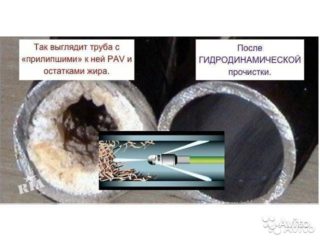 Hydro-flushing has a large number of advantages that distinguish it among other ways of servicing sewage:
Hydro-flushing has a large number of advantages that distinguish it among other ways of servicing sewage:
- The quality of cleansing. Mud growths of any size and degree of compaction are removed.
- Possibility of use in tortuous pipelines due to the use of a flexible hose.
- Speed. Rinsing even long communication lines is carried out promptly.
- Use in any weather. The cleaning efficiency does not decrease, even if the thermometer has dropped significantly below zero. Hydraulic flushing breaks and eliminates the ice plugs that form when pipes freeze.
- Safety for the environment. For punching sewer routes, only water is used. There is no need for pouring chemicals with a destructive effect. Thanks to this, cleaning does not pose any danger to the pipeline, nor to people and animals.
- Reduce the risk of re-clogging.As practice has shown, high-quality hydrotreating of the main line several times reduces the likelihood of new blockages: the pipes from the inside after washing become so smooth that the sediment on them appears much slower than before cleaning.
The technique is not limited in application. It is suitable for any type of piping, regardless of their configuration, material of manufacture and laying principle.
The main disadvantage of this method is the high price. This also applies to the purchase of hydraulic equipment for self-cleaning of pipelines, and the order of professional services. The prices for cleaning the sewage system in a hydrodynamic way start from 110 rubles per linear meter of the pipeline. The cost of the most inexpensive car is about 30,000 rubles.
The hydromechanical flushing method is effective and does not damage the system. It is suitable even for sewer highways, the dilapidated state of which does not allow cleaning by mechanical or chemical methods.
